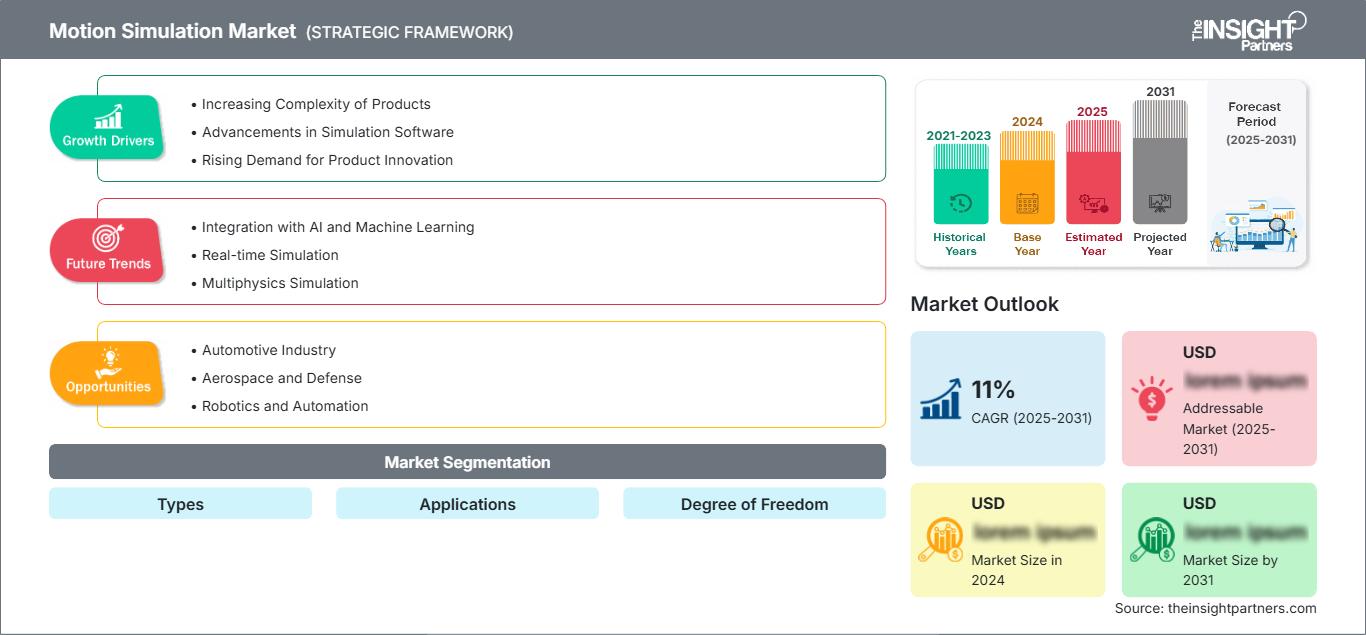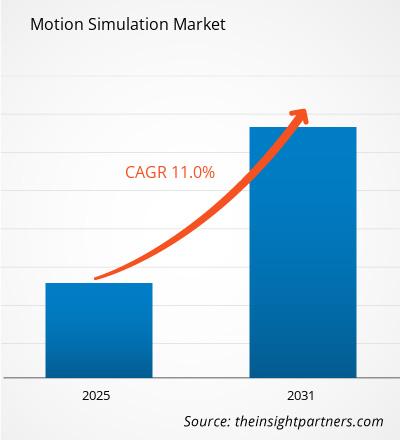Le marché de la simulation de mouvement devrait enregistrer un TCAC de 11 % entre 2025 et 2031, avec une taille de marché passant de XX millions de dollars américains en 2024 à XX millions de dollars américains d'ici 2031.
Le rapport est segmenté en fonction des types, des applications et du degré de liberté. L'analyse mondiale est ensuite ventilée au niveau régional et par principaux pays. Le rapport offre la valeur en dollars américains pour l'analyse et les segments ci-dessus.
Objectif du rapport
Le rapport sur le marché de la simulation de mouvement de The Insight Partners vise à décrire le paysage actuel et la croissance future, les principaux facteurs moteurs, les défis et les opportunités. Cela fournira des informations à diverses parties prenantes commerciales, telles que :
- Fournisseurs/fabricants de technologie : pour comprendre l’évolution de la dynamique du marché et connaître les opportunités de croissance potentielles, leur permettant de prendre des décisions stratégiques éclairées.
- Investisseurs : pour effectuer une analyse complète des tendances concernant le taux de croissance du marché, les projections financières du marché et les opportunités qui existent tout au long de la chaîne de valeur.
- Organismes de réglementation : pour réglementer les politiques et surveiller les activités du marché dans le but de minimiser les abus, de préserver la confiance des investisseurs et de maintenir l’intégrité et la stabilité du marché.
Types de segmentation du marché de la simulation de mouvement
Applications
Degré de liberté
Géographie
- Amérique du Nord
- Europe
- Asie-Pacifique
- Amérique du Sud et centrale
- Moyen-Orient et Afrique
Vous bénéficierez d’une personnalisation sur n’importe quel rapport - gratuitement - y compris des parties de ce rapport, ou une analyse au niveau du pays, un pack de données Excel, ainsi que de profiter d’offres exceptionnelles et de réductions pour les start-ups et les universités
Marché de la simulation de mouvement: Perspectives stratégiques

- Obtenez les principales tendances clés du marché de ce rapport.Cet échantillon GRATUIT comprendra une analyse de données, allant des tendances du marché aux estimations et prévisions.
Facteurs de croissance du marché de la simulation de mouvement
- Complexité croissante des produits : à mesure que les produits deviennent plus complexes, une simulation précise de leurs mouvements et de leurs performances devient essentielle.
- Progrès dans les logiciels de simulation : le développement de logiciels de simulation sophistiqués dotés de fonctionnalités puissantes stimule la croissance du marché.
- Demande croissante d'innovation de produits : pour rester compétitives, les entreprises investissent dans les technologies de simulation afin d'accélérer le développement et l'innovation de produits.
Tendances futures du marché de la simulation de mouvement
- Intégration à l'IA et à l'apprentissage automatique : l'IA et l'apprentissage automatique amélioreront la précision et l'efficacité de la simulation, permettant ainsi l'analyse prédictive et l'optimisation.
- Simulation en temps réel : la simulation en temps réel facilitera les itérations de conception rapides et les tests virtuels, réduisant ainsi les délais de mise sur le marché.
- Simulation multiphysique : la combinaison de plusieurs phénomènes physiques dans une seule simulation permettra une compréhension plus complète du comportement du produit.
Opportunités du marché de la simulation de mouvement
- Industrie automobile : la simulation de mouvement est essentielle pour la conception et les tests de véhicules, des performances du moteur aux systèmes de conduite autonome.
- Aérospatiale et défense : la simulation du mouvement des avions, des missiles et des satellites est essentielle pour garantir la sécurité et les performances.
- Robotique et automatisation : la simulation de mouvement joue un rôle clé dans le développement et l’optimisation des robots et des systèmes automatisés.
Aperçu régional du marché de la simulation de mouvement
Les tendances régionales et les facteurs influençant le marché de la simulation de mouvement tout au long de la période de prévision ont été analysés en détail par les analystes de The Insight Partners. Cette section aborde également les segments et la géographie du marché de la simulation de mouvement en Amérique du Nord, en Europe, en Asie-Pacifique, au Moyen-Orient et en Afrique, ainsi qu'en Amérique du Sud et en Amérique centrale.
Portée du rapport sur le marché de la simulation de mouvement
| Attribut de rapport | Détails |
|---|---|
| Taille du marché en 2024 | US$ XX million |
| Taille du marché par 2031 | US$ XX Million |
| TCAC mondial (2025 - 2031) | 11% |
| Données historiques | 2021-2023 |
| Période de prévision | 2025-2031 |
| Segments couverts |
By Types
|
| Régions et pays couverts | Amérique du Nord
|
| Leaders du marché et profils d'entreprises clés |
|
Densité des acteurs du marché de la simulation de mouvement : comprendre son impact sur la dynamique des entreprises
Le marché de la simulation de mouvement connaît une croissance rapide, portée par une demande croissante des utilisateurs finaux, due à des facteurs tels que l'évolution des préférences des consommateurs, les avancées technologiques et une meilleure connaissance des avantages du produit. Face à cette demande croissante, les entreprises élargissent leur offre, innovent pour répondre aux besoins des consommateurs et capitalisent sur les nouvelles tendances, ce qui alimente la croissance du marché.

- Obtenez le Marché de la simulation de mouvement Aperçu des principaux acteurs clés
- Analyse historique (2 ans), année de base, prévision (7 ans) avec TCAC
- Analyse PEST et SWOT
- Taille du marché Valeur / Volume - Mondial, Régional, Pays
- Industrie et paysage concurrentiel
- Ensemble de données Excel
Rapports récents
Témoignages
Raison d'acheter
- Prise de décision éclairée
- Compréhension de la dynamique du marché
- Analyse concurrentielle
- Connaissances clients
- Prévisions de marché
- Atténuation des risques
- Planification stratégique
- Justification des investissements
- Identification des marchés émergents
- Amélioration des stratégies marketing
- Amélioration de l'efficacité opérationnelle
- Alignement sur les tendances réglementaires




















 Obtenez un échantillon gratuit pour - Marché de la simulation de mouvement
Obtenez un échantillon gratuit pour - Marché de la simulation de mouvement